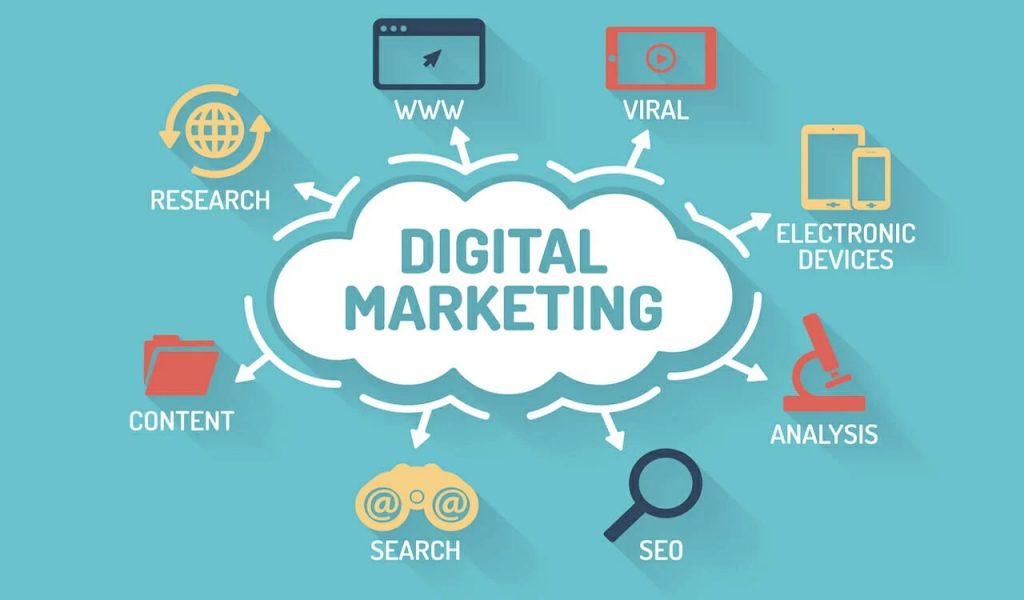Table of Contents
In the era of digital media, the internet is ruling the business landscape. The total number of people going online is increasing every day. 59.6% of the world population falls under internet users category in the first quarter of 2020. Moreover, the year-on-year growth rate of internet users is still increasing. In the 1990s, this sudden boom led to an introduction of a new promotional mix; Digital Marketing. Soon digital advertising became popular, and a need for Digital Marketing Strategy came into the picture.
Post Graduate Program Digital Marketing by Henry Harvin®
45-min online masterclass with skill certification on completion
$99 FREE
Access Expires in 24Hrs
Digital advertising has now become a new normal. It is often the first choice of marketers. When it comes to putting digital advertising to use, having a strategy is essential for a company to make the most out of it. Developing and implementing a Digital Marketing Strategy is not as easy as it sounds. Let us dive deeper into the guide of developing an effective Digital Marketing Strategy.
Step by Step Guide for Developing a Digital Marketing Strategy
A Digital Marketing Strategy is an essential aspect of successful marketing. Without a strategy, your campaign will most likely end up worthless. Therefore, it is imperative to have a properly planned strategy before plunging into the digital advertising world.

A good Digital Marketing Strategy should have a long term as well as a short-term plan. Although long-term plans are almost always better suited for digital advertising, short-term tactics can boost your capability to generate leads. Thus, a long-term strategy is the backbone of a digital marketing campaign, and short-term tactics act as a bonus for a short interval. In this blog, we will focus on developing a long-term strategy for digital advertising.
Do you want to master the essential disciplines in digital marketing? Check out the Digital Marketing Specialist course now!
Step 1: Research for Digital Marketing Strategy
Not just of Digital Marketing Strategy, research is the principal component of any strategy. Firstly, research should be done on the product/service, secondly on the customer persona, thirdly on the promotion platforms and lastly, on the competition. These four segments of research should give a clear picture of the current market scenario for digital advertising and answers the question: What should I do to improve my sales?

Research on product or service:
- The differentiation factor of your product/service
- Points of parity
- Future possibilities
- Collect information about product/service perception and performance
Research on customer persona:
- Collect information about the customers, e.g. age, gender, geographical location, etc.
- Identify the Key Performance Indicators (KPI) of your product/service using customer reviews
- Analyse the customer data to identify target segments
- It is essential during the research step (Step 1), as well as during the track progress step (Step 8)
Research on promotion platforms:
- Identify the ideal social media platform for your product, e.g. Instagram for fashion products, LinkedIn for professional services, etc.
- Perform Cost-Benefit Analysis for utilising digital advertising sections on each platform (various Social Media platforms and Google Adwords)
- Finalise your budget
Research on the competition:
- Figure out the ballpark of your performance using the performance data of the marketing campaign of your competitors
- Perform Competitive Analysis and find the differentiating factors
- Use the information about the competitor marketing campaigns to optimising the content (Step 5) so that your campaign can rank higher on search engine
Step 2: Target Audience
Using the research results, the primary focus of the Digital Marketing Strategy should be towards the customers. It is futile to spend money targeting the crowd. Therefore, it is imperative to identify the target audience among the population. It does not just save money; it also increases the chance of generating leads per unit of money spent on digital advertising.

The customer base could be classified into various segments using the features mentioned below.
The features are:
- Geography: Country, city, climate, population, etc. are used for segmentation. It is useful in launching regional products
- Demography: It uses age, gender, income, social status, occupation, etc. for segmentation. It is the most frequently used parameter for segmentation
- Psychography: It is segmented based on lifestyle, personality, beliefs, etc. It is subjective but helpful in expanding loyal customer base.
- Behavioural: It is segmentation based on the intent, benefits sought, purchases usage, etc.
After using the parameters mentioned above on the customer base, you should choose one or more of the segments, which are most likely to engage with your product/service. It is also essential to keep in mind that the selected segment may prefer one digital advertising platform over others. Selective targeting of customers will reduce the cost of digital advertising without losing possible leads.
Step 3: Set goals
Having the research work is done, and the target audience selected, now you should work on implementing your Digital Marketing Strategy. But wait, before you move forward, you need to define what do you want to achieve from this campaign.

This step is the most overlooked part of a strategy. You must be wondering the more, the better. Then why is it important to set a goal? Right? It is essential to have a definite target before starting the campaign because the goal will allow you to keep a track on it. If things are not going as expected and the goal is unsettled, then you can intervene early in the life cycle with a different short-term tactic to boost the performance. The knowledge about the campaign, whether it is going on the right track or not, is known only after setting a goal.
Step 4: Develop Content
In Steps 1 to 3, you have only gained tacit knowledge. There is nothing to show for your efforts. From Step 4 onwards, all the efforts that you put will reflect in the marketing campaign report.
Content is the skeleton of a Digital Marketing Strategy. How well your campaign performs will depend on how good is your content. Good content need not be a flowery one. It should be clear and easily understandable.
The content for any campaign should have the following:
- Keywords: It is of utmost importance to use the keywords at frequent intervals throughout your content. Keywords are helpful because it allows search engines to figure out the topic of the content semantically.
- Readability: The target audience should be in mind while writing the content. If the audience is not a subject matter expert, then it is advisable to avoid jargons and use layman terms. Keep the sentences short and engaging. The attention span of online readers is freakishly short. Therefore, it is essential to keep the content interesting and informative.
- Relevance: Every campaign has different specifications, and the content should be made compatible with them. In other words, the content should follow the theme of the campaign. It should be relevant to the customers, and it should answer, what is there in it for the customers?
Step 5: Search Engine Optimisation (SEO)
Most of the times, the implementation of Step 4 and 5 are together. For any Digital Marketing Strategy, it is crucial to have the content, search engine optimised. It means that you should develop it in such a way that the search engine finds it most relevant for a customer query of a targeted keyword.

Unoptimised content can lead to heavy lead losses. The competitor might rank higher in the keyword search. Thus, the customers will naturally visit the competitor first. The content should follow SEO best practices mentioned below to avoid such scenarios.
Few SEO best practices are:
- Accurate content description: Google puts weightage on title and headings. Therefore, avoid making them vague or misleading. Make sure you clearly describe the product/service in your content. Each content should have a separate title.
- Meta tags: Use meta tags to describe the content accurately. Keep the length of the description short and avoid stuffing unnecessary keywords.
- URL: The URL of your content should contain the keywords. If possible, include exact keywords as the target keyword or the title. Keep a simple directory structure to your content.
- Frequency: Schedule your content and keep posting them frequently. Post at least a content per week to keep yourself from fading away with time.
- Links: Add sufficient inbound (links to pages on your website) and outbound (links to pages on other websites) links in your content. Google rewards links of your content on other websites only if they are genuine. If they are spam, then Google will penalise your content. To know more about removing unwanted links, please visit the official Google website.
- Images: Always use pictures with your content. Instead of CSS, use HTML tags for inserting images. The name of the image file should be meaningful and use alt text to provide a brief description.
- Mobile friendly: In the latest major algorithmic update, Google is preferring mobile compatible webpages over others, especially for consumers accessing the internet through mobile devices. Therefore, you should optimise the image and make the content webpage mobile friendly. It will help in getting mobile user leads.
- Branding: Google search engine prefers contents from brands and ranks them higher. Therefore, you should focus not just on digital advertising, but also on building your brand. There is no clear-cut formula to define a brand. Hence, you should provide quality product/service and promote your product/service both digitally and physically.
Step 6: Social Media
Social media platforms provide the quickest access to customers in the current digital era. Digital Marketing Strategy is incomplete without the presence on one or more social media platforms. Each platform has a unique set of the consumer base.

Some of the social media platforms are:
- Instagram: Its users are photogenic. Therefore, the promotion of beauty products or fashion apparels on this platform is a natural choice. It is also popular among influencers. Promotion of your product through those influencers can act as an effective marketing gimmick. It is more suited for B2C type of marketing.
- LinkedIn: This social media platform is strictly for professionals. The consumer base on this platform prefers a formal approach. It is the ideal platform for marketing of B2C services. Most of the businesses also have their pages on this platform, which makes it suitable for B2B marketing too.
- Facebook: It prefers individuals over companies. Therefore, the theme and design of the platform are such that it becomes difficult for B2B marketing. It provides a private space for individuals to post about their personal life, disregarding the professional aspect. Because of this, Facebook becomes an ideal platform to promote your brand by building connections and informing them about your product/service, instead of directly selling or generating leads.
- YouTube: It has the second-largest user base after Facebook. It is different from other social media because users cannot interact with each other directly. YouTube provides digital advertising capabilities in the form of videos. It is a great platform to promote your brand effectively. Design a video content which is catchy and memorable and use YouTube for promotion. This platform is the best option to attract attention and deliver your content memorably and quickly.
- Twitter: It is an open-interaction platform where everything is visible to your followers. Power of twitter lies in its ability to trend keywords. Therefore, you need to post the contents with hashtags that will start a trend. It provides an opportunity to get your customers to talk about you which may help you in generating B2B or B2C leads.
Step 7: Pay Per Click (Paid Advertisements)
In a Digital Marketing Strategy, Pay Per Click is more of a short-term tactic than a long-term strategy. It refers to putting up a paid digital advertising section on Google search result pages or other websites using Google AdWords. It instantly boosts your lead-generating capabilities.
Be careful! Do not ditch the processes of improving organic search result rankings. It is easy to get carried away because of the hefty leads generated by the paid digital advertisement. Always keep in mind that a search engine optimised content will give a good return on investment ratio in long-term as compared to low return on investment ratio but, high lead counts in short-term paid digital advertisements.
While setting up a pay per click type of marketing campaign, you should consider the factors mentioned below.
The factors are:
- Audience: Use the result of step 3 to provide this information to Google. Google AdWords uses this information to target the audience, which matches the information you have provided (demographic, geographical, etc.) and searches the target keyword.
- Budget: Feed in the finalised budget amount to google. Based on the budget, Google will ensure that you get the desired number of leads. Google charges only for the generated leads. The defined budget will affect the amount you can bid on keywords. Google will display your paid digital advertising on the first page of the search result when your target audience searches those keywords.
- Campaigns: Google AdWords allows you to create and maintain numerous campaigns in parallel. Make sure you advertise only focused product/service per campaign. Make different campaigns for different categories of products/services.
- Conversions: Keeping an eye on the performance of a campaign helps you in making it efficient. Google AdWords provides all the information you need on its dashboard.
Step 8: Track Progress
Congratulations! You have crossed all the hurdles and successfully designed your Digital Marketing Strategy. The last step (Step 8) is a maintenance step. You need to keep a close watch on the performance of your campaign and timely adjust the strategy.
Tracking can help you to focus on what is essential for the campaign. It also helps in identifying faults or errors and allows you to run errands before it is too late. Not just in finding or fixing issues, tracking is also useful in portraying a realistic picture of your performance which helps in planning the next campaign.
Generating a report is also an essential aspect of this step. The report contains all the details of the campaign and its performance too. Not everybody knows what you know because of your extensive research in Step 1 and 2. However, all the stakeholders need to know everything about it without getting into its nitty-gritty. Campaign report can meet such expectations of the stakeholders.
The report should contain the following information:
- The Statement of Purpose: Mention the objective and the goal of the campaign at the beginning.
- Product/Service description: The stakeholders surely want to know whether the quality of the product/service is maintained, or it is just a hollow digital advertising stunt.
- Budget: Money speaks for itself. Most of the time, the money used is of investors. Therefore, investors always want to know how much and where you have to spend their money.
- Leads generated from the campaign: It is one of the most significant KPIs of the campaign. The success of the campaign is directly related to it. It gives a clear-cut idea of how the campaign is performing.
- Return on Investment: Despite being an easily derivable ratio, it should be present in the report because people would hate to do the math every time they want to review the performance. Therefore, it is advisable to put this ratio as well.
- Progress: The progress and performance should be present in the form of neat diagrams and flowcharts. It should describe whether the campaign is on track or not. If there are delays or issues, then it should depict how much it is off schedule or budget.
Conclusion
The step-by-step guide is just a framework to point the readers in the right direction. It is not an exhaustive list of the things to do to develop and implement a Digital Marketing Strategy. By no means, the readers should follow this guide strictly. Every scenario has different unforeseen challenges which might prove some points in this guide, futile. Be flexible and spend a significant amount of time on the research so that the following steps are free from hitches.
To conclude this guide, I must point out the optimized content is the key to a successful Digital Marketing campaign. Having good content is halfway through, and the other half is an ever-changing process. Never let yourself fade away in time. Always keep yourself, your content and your campaign updated.
By now, you must have realised that digital advertising is not a walk in the park. It needs in-depth knowledge and hands-on experience to run a successful campaign. If you are struggling in digital advertising or you want to start a new career in this domain, then enrol now to the Henry Harvin Digital Marketing Career or check out other options in the Digital Marketing Courses blog.
Post Graduate Program in Digital Marketing by Henry Harvin®
Ranked #1 Amongst the Top 5 Trending Digital Marketing Course by India Today | Validate your professional skills in the field of Digital Marketing
View Course

